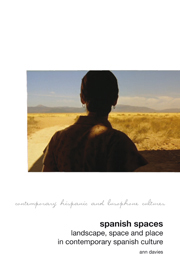Book contents
- Frontmatter
- Contents
- Acknowledgements
- List of illustrations
- 1 Introduction
- 2 Memory: landscapes of the past in Guillermo del Toro's Spanish films
- 3 Forgetting: the landscapes of Gonzalo Torrente Ballester
- 4 Landscape and identities in the Basque Country
- 5 Crime scene: landscape and the law of the land
- 6 Crime, scene, investigation: women, detection and the city
- 7 Coasting: tourism and landscape
- 8 Immigration: north (of) Africa
- 9 Conclusion
- Filmography
- Bibliography
- Index
1 - Introduction
- Frontmatter
- Contents
- Acknowledgements
- List of illustrations
- 1 Introduction
- 2 Memory: landscapes of the past in Guillermo del Toro's Spanish films
- 3 Forgetting: the landscapes of Gonzalo Torrente Ballester
- 4 Landscape and identities in the Basque Country
- 5 Crime scene: landscape and the law of the land
- 6 Crime, scene, investigation: women, detection and the city
- 7 Coasting: tourism and landscape
- 8 Immigration: north (of) Africa
- 9 Conclusion
- Filmography
- Bibliography
- Index
Summary
The rain in Spain stays mainly in the plain.
Alan Jay LernerDespite all you may have heard to the contrary, the rain in Spain stays almost invariably in the hills.
Michael FlandersThis book derives from my readings from the field of cultural geography in an attempt to reflect on the terrain of the entity known as Spain, through the prism of my scholarly interest in contemporary Spanish cinematic and literary texts. A further motivation is the difficulties I and others wrestle with in Hispanic Studies as we try to investigate questions bounded by an idea of nation, in an era when the whole notion of a nation is open to dispute and indeed discredit. Some scholars now talk of an era of ‘post-nationalism’ and sometimes by implication post-nation-ism, but the concept of nation, including that of the Spanish nation, still has some currency. As Joan Ramon Resina puts it, ‘political subjects themselves continue to correlate with their national foundation in ways that cannot simply be bracketed out of the political discourse’ (Resina 2002: 377); the same could be said of cultural discourse as well. To take just one example, the field of Spanish film studies increasingly encounters difficulties over the now strongly questioned concept of a Spanish national cinema as if the latter simply reproduced an essential, authentic Spain within its films and were impervious to outside influence.
- Type
- Chapter
- Information
- Spanish SpacesLandscape, Space and Place in Contemporary Spanish Culture, pp. 1 - 20Publisher: Liverpool University PressPrint publication year: 2012

